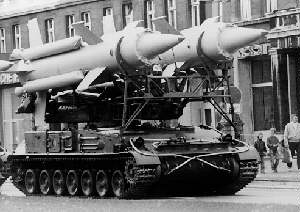 W
WA rocket launcher is a device that launches an unguided, rocket-propelled projectile, although the term is often used in reference to mechanisms that are portable and capable of being operated by an individual.
 W
WThe Gyrojet is a family of unique firearms developed in the 1960s named for the method of gyroscopically stabilizing its projectiles. Rather than inert bullets, Gyrojets fire small rockets called Microjets which have little recoil and do not require a heavy barrel or chamber to resist the pressure of the combustion gases. Velocity on leaving the tube was very low, but increased to around 1,250 feet per second (380 m/s) at 30 feet (9.1 m). The result is a very lightweight weapon.
 W
WThe Jobaria Defense Systems Multiple Cradle Launcher, also called Jahanam Launcher, is an Emirati made multiple rocket launcher unique to the United Arab Emirates Army. It has 240 tubes making it the world's largest rocket artillery by tube count. It is thought to function as a combined form of BM-21 Grad multiple rocket launcher. It is developed by a joint venture between Al Jaber Land System and ROKETSAN.
 W
WA launch pad is an above-ground facility from which a rocket-powered missile or space vehicle is vertically launched. The term launch pad can be used to describe just the central launch platform, or the entire complex. The entire complex will include a launch mount or launch platform to physically support the vehicle, a service structure with umbilicals, and the infrastructure required to provide propellants, cryogenic fluids, electrical power, communications, telemetry, rocket assembly, payload processing, storage facilities for propellants and gases, equipment, access roads, and drainage.
 W
WA missile turret is a device used to aim missiles towards their targets before launch. Similarly to gun turrets they have been used on warships and vehicles on the ground. In most roles articulated missile launching systems on warships have been replaced by vertical launching systems. Ship-based missile systems often have centralised guidance systems which eliminate the need for targeting sensors on the turrets themselves.
 W
WThe N-2 is an Armenian multiple rocket launcher designed and produced by the Garni-ler company starting no later than 2011. Armenia has not released much information regarding the rocket system, however it is apparent that the N-2 is being mass-produced, and is in active use by the Armenian Armed Forces, and likely the Nagorno-Karabakh Defense Army. The system was developed onto the GAZ-3308, a Russian military truck. The launcher is mainly used with Armenian TB-1 thermobaric missiles and RPG-7 grenades, but is designed to be compatible with a wide variety of ammunition from many different countries. The launcher, holding up to 12 rockets, is fired using a remote electrical panel, and can be fired in single shots or in a salvo for up to 10 seconds.
 W
WPanzerschreck was the popular name for the Raketenpanzerbüchse 54, an 88 mm reusable anti-tank rocket launcher developed by Nazi Germany in World War II. Another earlier, official common name was Ofenrohr.
 W
WA transporter erector launcher (TEL) is a missile vehicle with an integrated prime mover that can carry, elevate to firing position and launch one or more missiles. Such vehicles exist for both surface-to-air missiles and surface-to-surface missiles. Early on, such missiles were launched from fixed sites and had to be loaded onto trucks for transport, making them more vulnerable to attack since once they were spotted by the enemy they could not easily be relocated, and if they were it often took hours or even days to prepare them for launch once they reached their new site.
 W
WThis is a list of U.S. Army rocket launchers by model number. Launchers can be either tube-type or rail-type.
 W
WThe Walid is a wheeled armored personnel carrier based on the BTR-152 and the BTR-40, built by the Arab Organization for Industrialization (AOI). It was used by Egypt during the 1967 war with Israel.